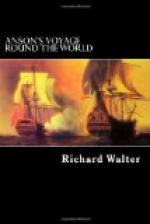The weather proving somewhat more dominate on the 27th, we sent our boat for the captain of the Trial, who, when he came on board us, produced an instrument, signed by himself and all his officers, representing that the sloop, besides being dismasted, was so very leaky in her hull that even in moderate weather it was necessary to keep the pumps constantly at work, and that they were then scarcely sufficient to keep her free; so that in the late gale, though they had all been engaged at the pumps by turns, yet the water had increased upon them; and, upon the whole, they apprehended her to be at present so very defective that if they met with much bad weather they must all inevitably perish, and therefore they petitioned the Commodore to take some measures for their future safety. But the refitting of the Trial and the repairing of her defects was an undertaking that in the present conjuncture greatly exceeded his power; and besides, it would have been extreme imprudence in so critical a juncture to have loitered away so much time as would have been necessary for these operations. The Commodore, therefore, had no choice left him but that of taking out her people and destroying her; but at the same time, as he conceived it necessary for His Majesty’s Service to keep up the appearance of our force, he appointed the Trial’s prize (which had been often employed by the Viceroy of Peru as a man-of-war) to be a frigate in His Majesty’s Service, manning her with the Trial’s crew and giving new commissions to the captain and all the inferior officers accordingly. This new frigate, when in the Spanish service, had mounted thirty-two guns, but she was now to have only twenty, which were the twelve that were on board the Trial, and eight that had belonged to the Anna pink. When this affair was thus far regulated, Mr. Anson gave orders to Captain Saunders to put it in execution, directing him to take out of the sloop the arms, stores, ammunition, and everything that could be of any use to the other ships, and then to scuttle her and sink her. And after Captain Saunders had seen her destroyed he was to proceed with his new frigate (to be called the Trial’s prize) and to cruise off the high land of Valparaiso, keeping it from him north-north-west, at the distance of twelve or fourteen leagues. For as all ships bound from Valparaiso to the northward steer that course, Mr. Anson proposed by this means to stop any intelligence that might be despatched to Callao of two of their ships being missing, which might give them apprehensions of the English squadron being in their neighbourhood. The Trial’s prize was to continue on this station twenty-four days and if not joined by the Commodore at the expiration of that term, she was then to proceed down the coast to Pisco, or Nasca, where she would be certain to meet with Mr. Anson. The Commodore likewise ordered Lieutenant Suamarez who commanded the Centurion’s prize, to keep company with Captain Saunders both to assist him in unloading the sloop, and also that, by spreading in their cruise, there might be less danger of any of the enemy’s ships slipping by unobserved. These orders being despatched, the Centurion parted from them at eleven in the evening on the 27th of September, directing her course to the southward, with a view of cruising for some days to the windward of Valparaiso.




